Shrimp Stir Fry with Tamari Sauce (Easy & Flavorful)
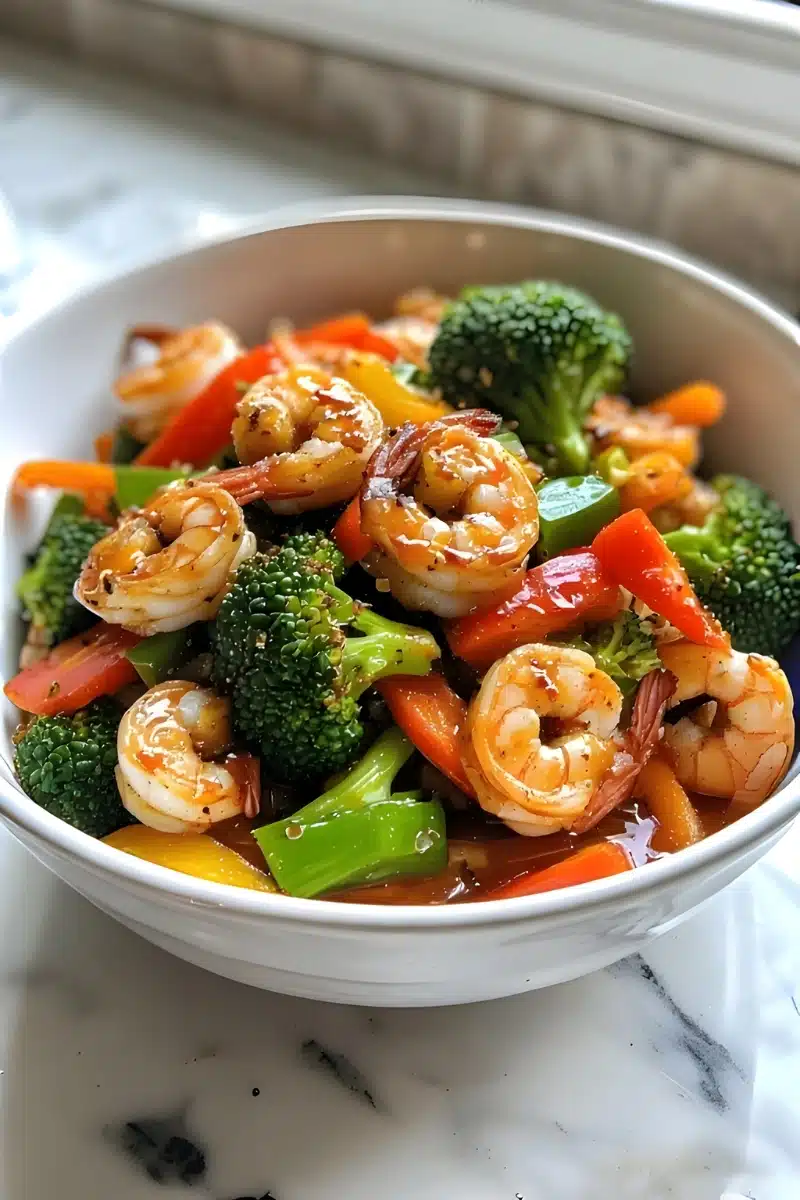
Hi there! I’m Sunny. My passion for cooking started when I had to remove dairy from my diet, but it opened a new world of flavor exploration. One dish I constantly rely on is shrimp stir fry with tamari sauce. It’s quick, healthy, gluten-free, and packed with savory umami flavors. What I love most is how tamari gives this stir fry a rich depth without the sharp saltiness of regular soy sauce. This recipe is not just a simple dinner solution—it’s my favorite go-to for a satisfying meal that feels both comforting and nourishing. Whether you are looking for a healthy shrimp stir fry, tips for juicy, tender shrimp, or a simple tamari-based sauce, this guide has you covered.
Need more quick meals that don’t compromise on flavor? Explore these 20-minute gluten free dinner recipes that are just as fast and flavorful.
Table of Contents
Why Choose Tamari for Shrimp Stir Fry with Tamari Sauce
What is Tamari Sauce
Tamari is a Japanese-style soy sauce alternative made from fermented soybeans without wheat, which makes it naturally gluten-free. When making shrimp stir fry with tamari sauce, tamari delivers a smoother, richer flavor compared to regular soy sauce. Its mild saltiness lets the natural sweetness of the shrimp stand out while adding a deep savory note.
Tamari vs Soy Sauce: What’s the Difference
- Tamari: Gluten-free, thicker texture, richer umami, and less salty
- Soy Sauce: Contains wheat (unless specified gluten-free), thinner consistency, sharper, and saltier
When preparing shrimp stir fry with tamari sauce, tamari proves to be the better option for both flavor depth and dietary flexibility.
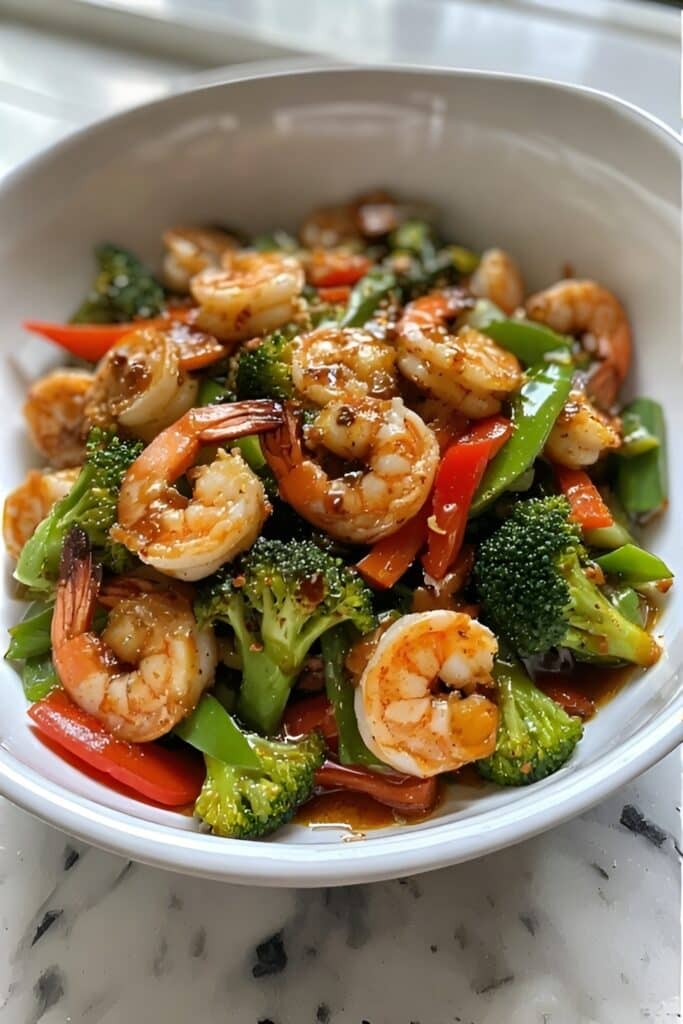
Is Tamari Good for Stir-Fry (Benefits and Flavor)
Yes, tamari is excellent for stir-fry. In recipes like shrimp stir fry with tamari sauce, tamari provides:
- A velvety coating that clings to shrimp and vegetables beautifully
- Balanced umami without being overpowering
- A gluten-free alternative for those avoiding wheat
- Perfect pairing with garlic, ginger, sesame oil, and a variety of vegetables
Flavor tip: For the best tamari stir fry sauce, combine tamari with rice vinegar, toasted sesame oil, minced garlic, and a touch of maple syrup or sugar. This simple mix elevates any shrimp stir fry with tamari sauce from basic to restaurant-quality.
Can You Replace Soy Sauce with Tamari (Yes—Here’s How)
Absolutely. Tamari can replace soy sauce in any stir-fry recipe with a simple one-to-one ratio. When preparing shrimp stir fry with tamari sauce, tamari delivers the same savory backbone as soy sauce but with a smoother finish and without the sharp saltiness. It is especially useful for anyone looking for a healthier, gluten-free alternative that still delivers deep, rich flavor.
Ingredients That Pair Perfectly
Core Ingredients for This Shrimp Stir Fry with Tamari Sauce
To make this shrimp stir fry with tamari sauce flavorful and balanced, you only need simple, wholesome ingredients. Each ingredient plays a role in creating the perfect balance of savory, sweet, and fresh flavors. Here is what you will need:
- Shrimp – Large, peeled, and deveined. Fresh or frozen works.
- Tamari Sauce – The base of the stir fry sauce. Rich and savory.
- Vegetable Oil or Avocado Oil – High smoke point oils perfect for stir-frying.
- Garlic and Ginger – Fresh, finely minced. Essential for building flavor.
- Vegetables – Bell peppers, broccoli, snap peas, carrots, or whatever you have on hand.
- Rice Vinegar or Lime Juice – Adds brightness and balance to the tamari-based sauce.
- Sesame Oil – A small amount for finishing. Adds nutty depth.
- Optional Sweetener – Maple syrup, honey, or coconut sugar to round out the salty-savory profile.
This combination creates a versatile and adaptable base for any shrimp stir fry with tamari sauce.
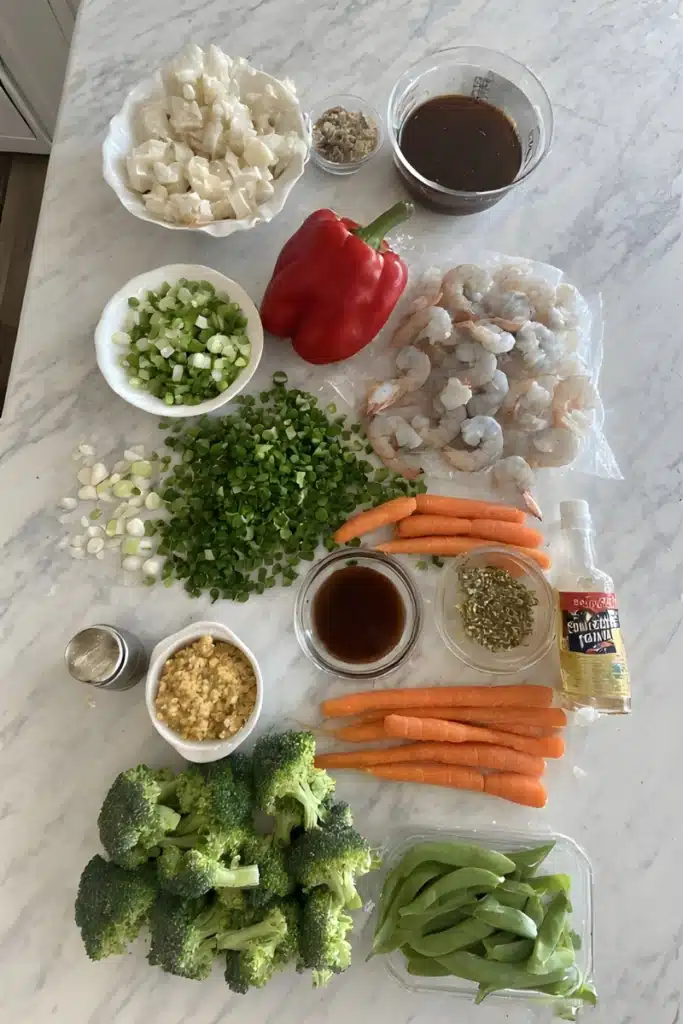
What Pairs Well with Tamari
Tamari’s deep umami flavor complements a wide range of ingredients. When building your shrimp stir fry with tamari sauce, pair it with:
- Aromatics: Garlic, ginger, scallions, and chili flakes.
- Crunchy Vegetables: Broccoli, bell peppers, carrots, snap peas, bok choy.
- Leafy Greens: Baby spinach, kale, or cabbage wilt beautifully into stir-fries.
- Grains: Jasmine rice, brown rice, cauliflower rice, or noodles.
- Nuts & Seeds: Cashews, sesame seeds, or slivered almonds for texture.
- Citrus: A squeeze of lime or lemon enhances brightness and balances the salty-sweet flavors.
If you’re in the mood for something heartier, this lemon garlic chicken with roasted veggies delivers vibrant flavor in one pan.
Best Oil for Stir-Fry with Tamari
Choosing the right oil is critical in stir-frying because it directly impacts texture and flavor. The best oils for making shrimp stir fry with tamari sauce are those with high smoke points and neutral or slightly nutty flavors. Recommended options include:
- Avocado Oil – Neutral, high smoke point, and heart-healthy.
- Grapeseed Oil – Light flavor and ideal for high-heat cooking.
- Canola or Vegetable Oil – Affordable and commonly used for stir-fry.
- Peanut Oil – Slightly nutty flavor, excellent for Asian-style dishes.
Avoid oils like olive oil for stir-frying, as they have low smoke points and can burn, affecting the flavor of your shrimp stir fry with tamari sauce.
Secrets to Perfect Shrimp Stir Fry
How Do Chinese Restaurants Get Their Shrimp So Tender
The secret behind tender shrimp in Chinese restaurants lies in a technique called velveting. This method involves marinating shrimp in a mixture of cornstarch, egg white, and sometimes a little rice wine or oil. Then, the shrimp are briefly blanched in oil or water before stir-frying. This creates a protective coating that locks in moisture, giving the shrimp a silky, juicy texture.
For shrimp stir fry with tamari sauce, you can velvet your shrimp by:
- Mixing shrimp with 1 tablespoon cornstarch, 1 teaspoon oil, and 1 teaspoon rice wine or dry sherry.
- Letting it sit for 10–15 minutes.
- Quickly blanching in hot water or oil for 30 seconds before stir-frying.
This step is optional but highly recommended for restaurant-quality results.
Should You Marinate Shrimp for Stir-Fry
Yes, but keep it simple. Shrimp are delicate and don’t need long marinating times. For shrimp stir fry with tamari sauce, a quick 10–15 minute marinade enhances flavor without affecting texture.
A basic marinade includes:
- 2 tablespoons tamari sauce
- 1 teaspoon garlic (minced)
- 1 teaspoon ginger (minced)
- 1 teaspoon sesame oil
- A pinch of sugar or maple syrup for balance
Marinating beyond 20 minutes isn’t necessary and may cause the shrimp to become mushy.
What Makes Shrimp Taste Better (Seasoning and Techniques)
Several factors elevate the flavor of shrimp stir fry with tamari sauce:
- Proper Drying: Pat shrimp completely dry before cooking to achieve better searing.
- High Heat: Stir-fry quickly over medium-high to high heat to lock in moisture and create slight caramelization.
- Balanced Sauce: Combine tamari with rice vinegar, sesame oil, a touch of sugar, and fresh aromatics for a perfect stir fry sauce.
- Timing: Cook shrimp just until opaque—typically 2-3 minutes. Overcooking makes them rubbery.
What Makes Stir-Fry Taste Better (Sauces, Heat, and Timing)
Great stir-fry is about balancing flavors and executing fast cooking with precision. For shrimp stir fry with tamari sauce, keep these keys in mind:
- Hot Pan, Cold Oil: Always heat the pan first, then add oil. This prevents sticking and improves browning.
- Layer Flavors: Start with aromatics like garlic and ginger, then add shrimp, followed by vegetables and sauce.
- Sauce Balance: Salty (tamari), sweet (maple or sugar), sour (rice vinegar or lime), and umami (shrimp and tamari).
- Avoid Overcrowding: Stir-fry in batches if needed. Overcrowding lowers the pan temperature and leads to steaming instead of searing.
Mastering these simple techniques transforms shrimp stir fry with tamari sauce from an average dish into an extraordinary meal.
Or, if tacos are more your style, these ground beef tacos with corn tortillas are another gluten free winner made in 20 minutes.
Step-by-Step Cooking Guide
Prepping Shrimp and Vegetables Properly
Proper prep is the foundation of a great shrimp stir fry with tamari sauce. Stir-frying happens quickly, so everything should be ready before turning on the stove.
- Shrimp: Peel, devein, and pat dry. Optionally, velvet the shrimp for extra tenderness.
- Vegetables: Slice into uniform pieces for even cooking. Softer vegetables like bell peppers can be cut larger, while firmer ones like carrots should be sliced thinner.
- Sauce: Mix tamari, rice vinegar, sesame oil, a pinch of sugar, and water or broth in a small bowl, ready to pour.
- Aromatics: Mince garlic, ginger, and chop scallions.
Organize everything near the stove so the cooking process stays smooth and fast.
Cooking Order: Shrimp, Vegetables, and Sauce Timing
Cooking in the right order ensures perfect texture and flavor for shrimp stir fry with tamari sauce.
- Heat Pan: Preheat a wok or large skillet over medium-high to high heat until hot.
- Add Oil: Pour in high smoke-point oil like avocado or peanut oil.
- Cook Shrimp: Stir-fry shrimp for about 2-3 minutes until pink and opaque. Remove and set aside.
- Stir-Fry Vegetables: Add harder veggies like carrots or broccoli first. After 1-2 minutes, add quicker-cooking veggies like bell peppers or snap peas. Stir-fry for another 2-3 minutes.
- Return Shrimp: Add shrimp back to the pan.
- Pour Sauce: Stir in the tamari stir fry sauce. Toss everything together for 1-2 minutes until coated and heated through.
- Finish: Turn off heat, drizzle with a touch of sesame oil, and garnish with scallions or sesame seeds.
Serve immediately over rice, noodles, or a grain of your choice.
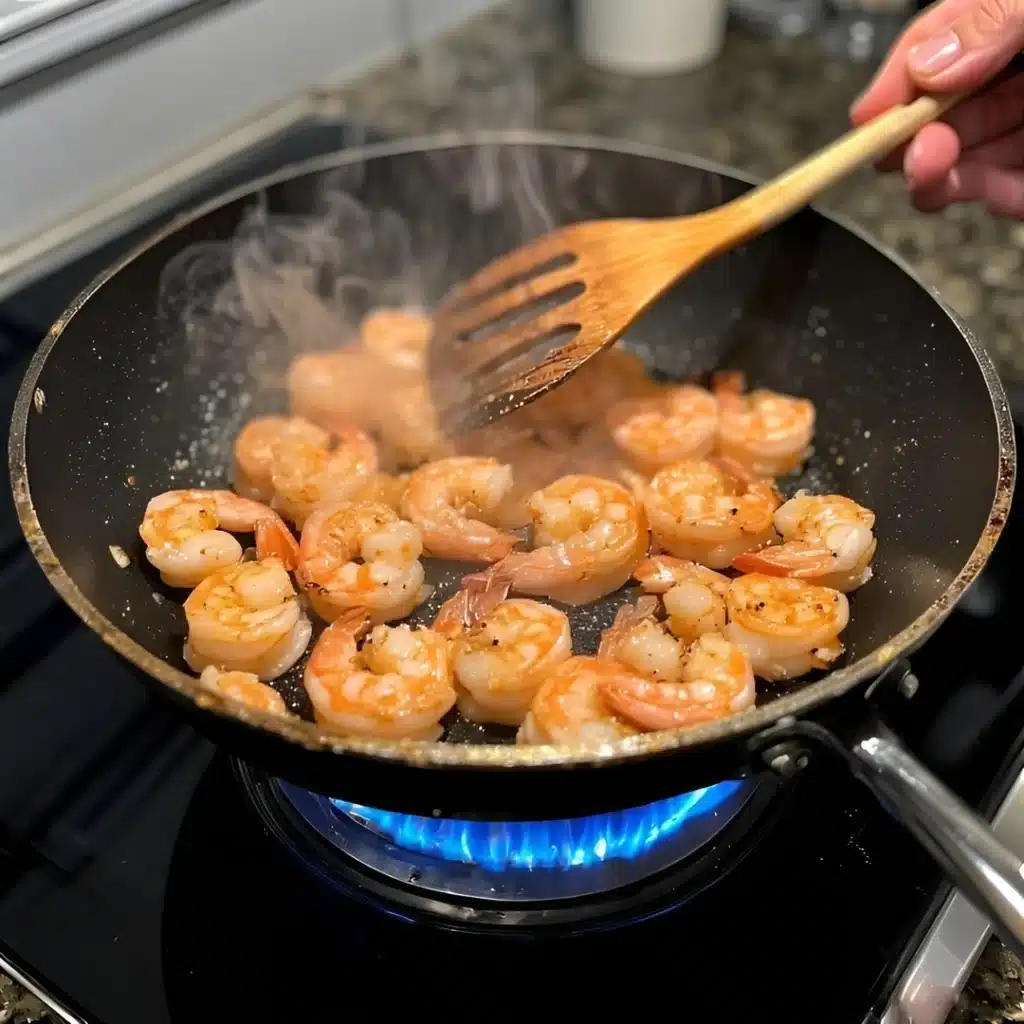
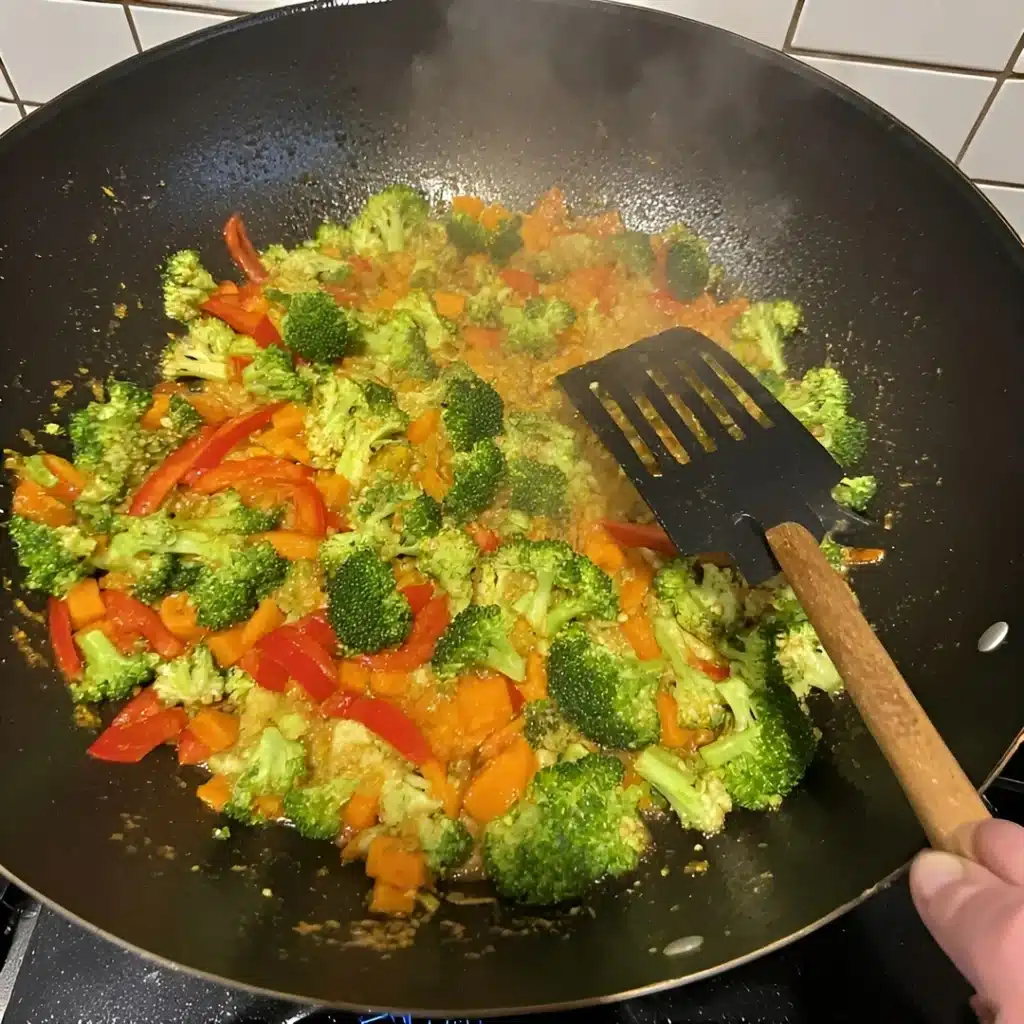
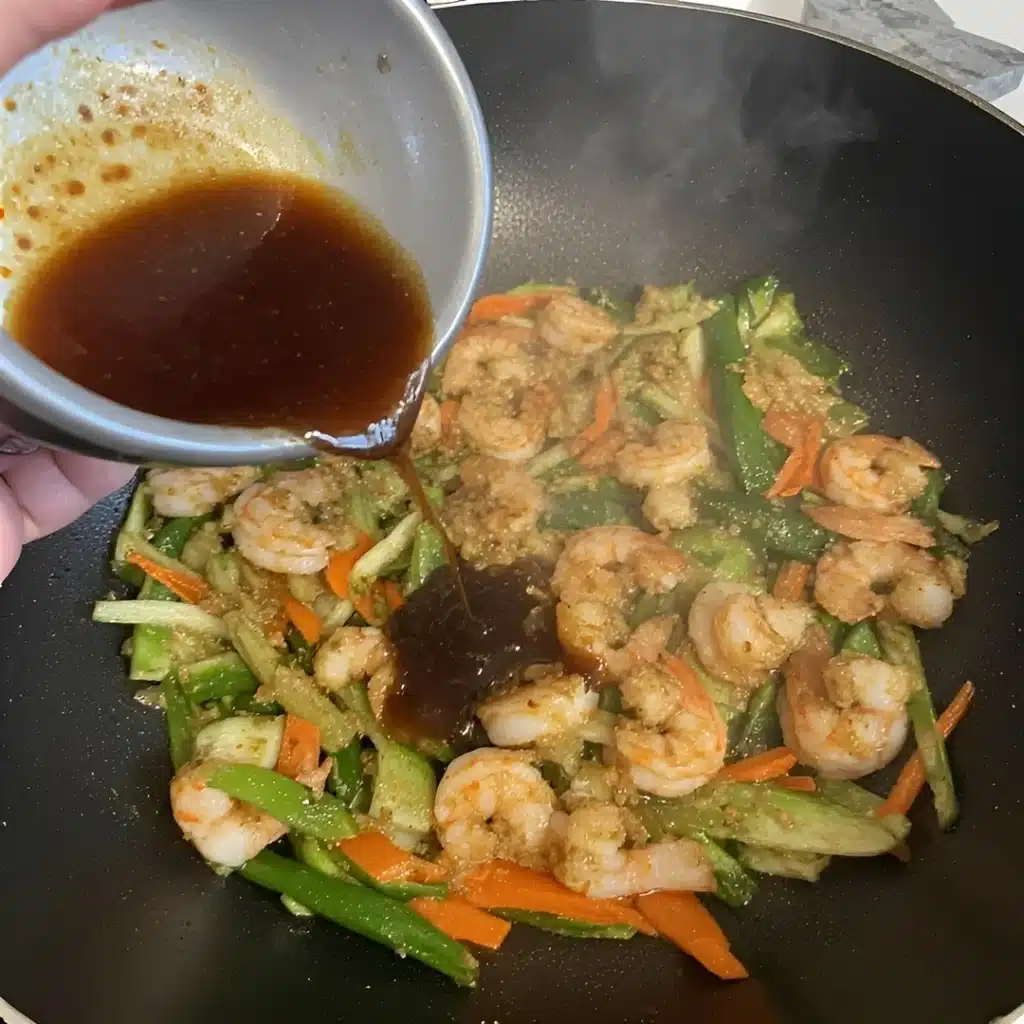
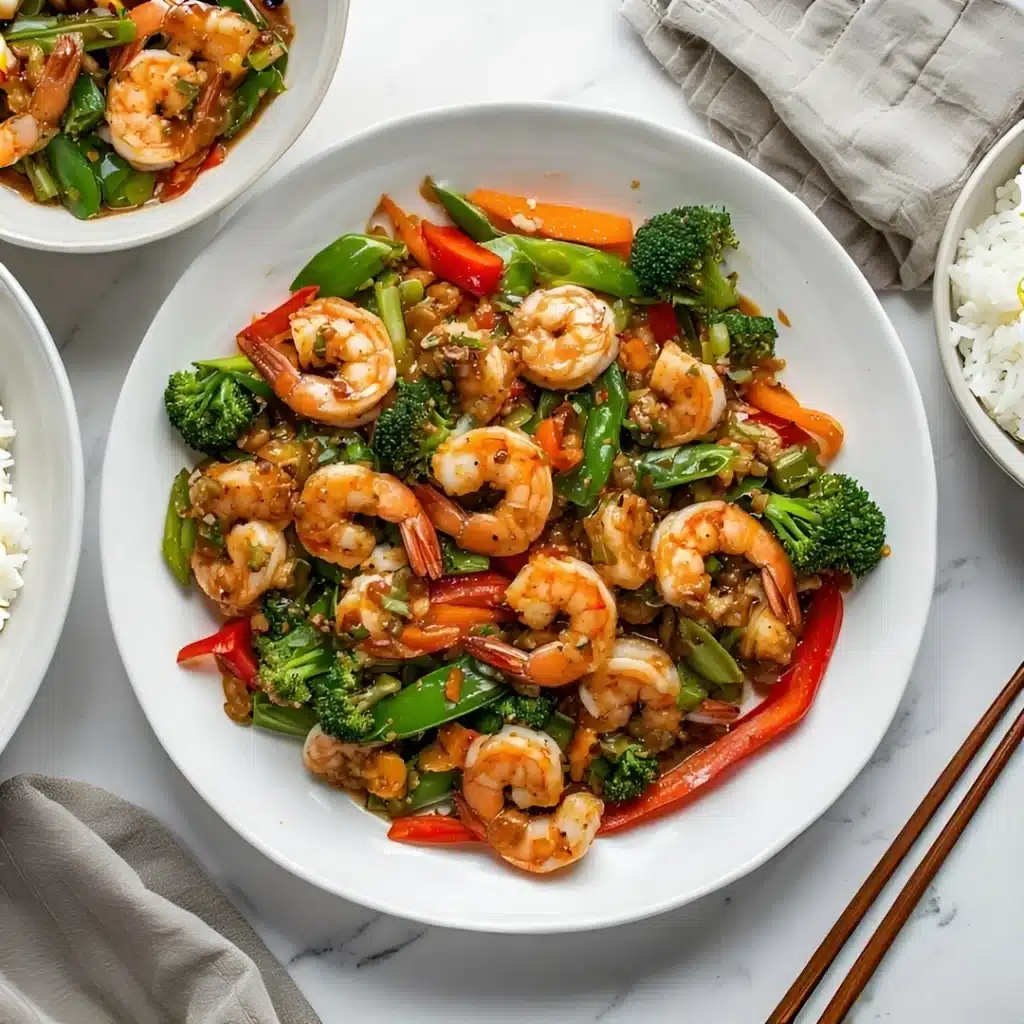
What Not to Put in Stir-Fry (Common Mistakes to Avoid)
Avoiding mistakes keeps your shrimp stir fry with tamari sauce flavorful and texturally perfect. Common errors include:
- Overcrowding the Pan: Leads to steaming, not searing. Stir-fry in batches if necessary.
- Using Low Smoke-Point Oils: Oils like olive oil burn easily and affect flavor.
- Overcooking Shrimp: Cook only until opaque. Overcooked shrimp become rubbery.
- Adding Too Much Sauce at Once: Sauce should coat, not drown, the stir fry. Excess sauce makes the dish soggy.
- Skipping Prep: Stir-frying is fast. If ingredients aren’t prepped, things burn quickly while you’re chopping.
Pro Tips for Crispy, Juicy, Flavorful Results
- High Heat is Non-Negotiable: The wok or skillet must be hot before ingredients go in.
- Dry Ingredients: Excess moisture prevents browning. Dry shrimp and veggies thoroughly.
- Cook Proteins Separately: Searing shrimp separately prevents overcooking and allows vegetables to stay crisp.
- Balance Your Sauce: A mix of salty (tamari), sweet (maple syrup), acidic (rice vinegar), and aromatic (garlic, ginger) creates the most flavorful shrimp stir fry with tamari sauce.
These techniques ensure your stir fry comes out perfectly seared, flavorful, and never soggy.
Storage, Leftovers, and Substitutions
Does Tamari Need to Be Refrigerated
Yes, tamari should be refrigerated after opening. While the high salt content helps preserve it, refrigeration maintains its quality, flavor, and freshness for a longer period. Unopened bottles can be stored in a cool, dark pantry, but once opened, store tamari in the fridge where it will typically last up to six months or more.
Storing Cooked Shrimp Stir Fry Safely
If you have leftovers from your shrimp stir fry with tamari sauce, follow these simple storage guidelines:
- Cool Completely: Let the stir fry cool before refrigerating.
- Airtight Containers: Store in airtight glass or BPA-free containers.
- Refrigerator: Keeps well for up to 3 days.
- Freezer: You can freeze shrimp stir fry, but note that shrimp may become slightly rubbery upon thawing. Freeze for up to 2 months.
Reheating Tips:
- Use a skillet over medium heat with a splash of water or broth to loosen the sauce.
- Avoid microwaving for too long as it may make the shrimp tough.
Other Substitutions: Gluten-Free, Low-Sodium, Vegetarian Tweaks
Shrimp stir fry with tamari sauce is naturally gluten-free because tamari contains no wheat. Here are some easy adjustments based on dietary needs:
- Low-Sodium Option: Use low-sodium tamari or reduce the amount of tamari and balance with extra rice vinegar and a touch more sweetener.
- Vegetarian/Vegan: Swap shrimp for tofu, tempeh, or mushrooms. Firm tofu works especially well when pressed and pan-fried until crispy, if you want a plant-based meal that’s just as quick? Try this chickpea and veggie Buddha bowl packed with roasted chickpeas and creamy tahini dressing..
- Soy-Free: Use coconut aminos instead of tamari. It’s sweeter but still offers umami flavor.
- Grain Alternatives: Serve over cauliflower rice, quinoa, or gluten-free noodles instead of traditional rice.
These substitutions keep the dish flexible while maintaining the integrity of the shrimp stir fry with tamari sauce concept.
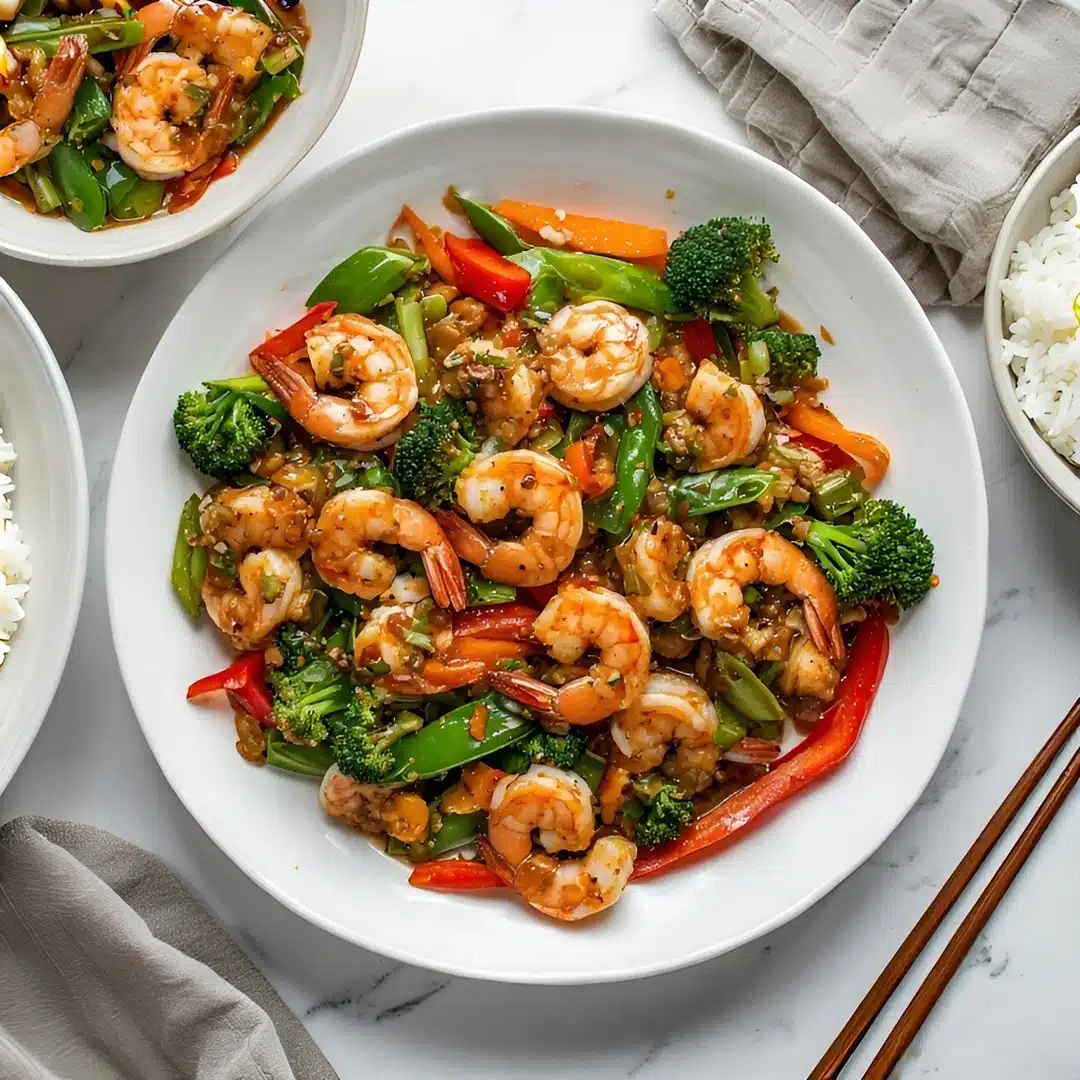
Shrimp Stir Fry with Tamari Sauce
Ingredients
Equipment
Method
- In a bowl, mix tamari, rice vinegar, sesame oil, garlic, ginger, and sugar to form the sauce.
- Heat avocado oil in a wok or large skillet over medium-high heat.
- Stir-fry the shrimp for 2–3 minutes until pink and opaque. Remove from the pan and set aside.
- Add mixed vegetables to the wok. Stir-fry for 3–4 minutes until crisp-tender.
- Return the shrimp to the wok. Pour in the sauce and stir well to coat everything evenly.
- Cook for an additional 1–2 minutes until heated through. Serve immediately over rice or your choice of base.
Nutrition
Notes
Tried this recipe?
Let us know how it was!FAQ Section
Is Tamari Good for Stir-Fry
Yes, tamari is excellent for stir-frying. Its thicker texture helps sauce cling better to proteins and vegetables, and it provides deep, smooth umami flavor without the harsh saltiness found in regular soy sauce. It’s also naturally gluten-free, making it ideal for gluten-sensitive diets.
Can You Replace Soy Sauce with Tamari Sauce
Absolutely. Tamari is a direct one-to-one substitute for soy sauce in any stir-fry recipe. In fact, many prefer it for its richer flavor and lower sodium profile. When making shrimp stir fry with tamari sauce, tamari provides all the savory depth without the wheat.
What Pairs Well with Tamari
Tamari pairs well with a wide variety of ingredients commonly used in stir-fries, including garlic, ginger, scallions, sesame oil, bell peppers, broccoli, snap peas, carrots, mushrooms, tofu, shrimp, and even citrus like lime or lemon. Grains like jasmine rice, brown rice, or noodles also complement tamari-based stir-fry dishes beautifully.
How Do Chinese Restaurants Get Their Shrimp So Tender
They use a technique called velveting, where shrimp are briefly marinated in a mixture of cornstarch, oil, and rice wine, then quickly blanched before stir-frying. This creates a silky coating that locks in moisture, keeping shrimp tender and juicy.
Conclusion
Shrimp stir fry with tamari sauce is the perfect combination of quick, healthy, and full-flavored cooking. This recipe proves that with a few simple techniques—like choosing the right oil, velveting shrimp for tenderness, and balancing a homemade tamari stir fry sauce—you can achieve restaurant-quality results right at home. Whether you are gluten-free, dairy-free, or simply looking for a fast dinner idea, this stir fry delivers savory satisfaction every time.
For more flavorful, allergy-friendly meals, explore my recipes for Dairy-Free Chicken Stir Fry or Teriyaki Tofu Stir Fry or gluten free pasta primavera. Each dish is designed to help you cook with confidence while enjoying meals that are both simple and delicious.






